A Project of the Hudson River Estuary Program
Compiled by Tom Lake, Consulting Naturalist
COVID-19 Guidance for Enjoying the Outdoors
While enjoying outdoor spaces, please continue to follow the CDC/NYSDOH guidelines for preventing the spread of colds, flu, and COVID-19. To find out more about enjoying DEC lands and New York's State Parks, visit DEC's website Play Smart*Play Safe*Play Local; https://www.dec.ny.gov/outdoor/119881.html
Keep at least six (6) feet of distance between you and others.
Wear a cloth face covering in public settings where social distancing measures are difficult to maintain.
Avoid close contact, such as shaking hands, hugging, and kissing.
Wash hands often or use a hand sanitizer when soap and water are not available.
Avoid surfaces that are touched often, such as doorknobs, handrails, and playground equipment.
DEC recommends avoiding busy trailheads. Find the trails less traveled and visit when trails may not be as busy during daylight hours.
Overview
For those of us who already miss summer, a series of record-setting warm days this week, from the High Peaks of the Adirondacks to Manhattan, were truly a highlight. The freshwater-loving harbor seal at Saugerties passed 15 months in residence and appeared as comfortable and curious as ever. Our Fall Natural History Program section now includes a new array of educational possibilities.
Highlight of the Week
11/11 – Poughkeepsie, HRM 75: For the fifth day in a row, air temperatures—72 to 78 degrees Fahrenheit (F)—tied or exceeded the record high for the date.
- National Weather Service
Natural History Entries
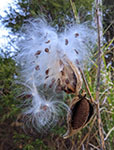 11/7 – Kingston, HRM 92: While walking in my neighborhood today, I found some milkweed (Asclepias syriaca), many of whose pods were ready to release their seeds to the next gust of wind. Other pods were still waiting with their seeds so perfectly packaged. (Photo of milkweed courtesy of Nancy Beard) 11/7 – Kingston, HRM 92: While walking in my neighborhood today, I found some milkweed (Asclepias syriaca), many of whose pods were ready to release their seeds to the next gust of wind. Other pods were still waiting with their seeds so perfectly packaged. (Photo of milkweed courtesy of Nancy Beard)
- Nancy Beard
 11/7 – Dutchess County, HRM 100: I was hiking the Quarry Hill Trail (1,600-foot elevation), an access trail that leads from the western side of the Taconic range up to the South Taconic Trail just south of Brace Mountain. It was on the trail where I stumbled upon a small northern red-bellied snake (Storeria occipitomaculata) on a west-facing, sun-warmed rock. It was very small, maybe six-inches-long, and slender as a chopstick. I watched it register my presence and struggle to scale a steep rock face. The snake succeeded in getting up by moving to an adjacent moss-covered rock a few inches away and then made its way through the greenery and into the leaf litter off the trail. (Photo of northern red-bellied snake courtesy of Moira Stone) 11/7 – Dutchess County, HRM 100: I was hiking the Quarry Hill Trail (1,600-foot elevation), an access trail that leads from the western side of the Taconic range up to the South Taconic Trail just south of Brace Mountain. It was on the trail where I stumbled upon a small northern red-bellied snake (Storeria occipitomaculata) on a west-facing, sun-warmed rock. It was very small, maybe six-inches-long, and slender as a chopstick. I watched it register my presence and struggle to scale a steep rock face. The snake succeeded in getting up by moving to an adjacent moss-covered rock a few inches away and then made its way through the greenery and into the leaf litter off the trail. (Photo of northern red-bellied snake courtesy of Moira Stone)
- Moira Stone
[For more information on the northern red-bellied snake, see The Amphibians and Reptiles of New York State (Gibbs-Breisch-Ducey-Johnson-Beher-Bothner 2007), or go to: https://www.dec.ny.gov/docs/wildlife_pdf/lessersnakes.pdf. Jesse Jaycox]
11/7 – Bedford, HRM 35: We spotted 45 migrating raptors at the Bedford Audubon Chestnut Ridge Hawkwatch today including two bald eagles. Red-shouldered hawk was high count with 24. Turkey vulture (65) led among non-raptor migrants that also included fish crow (26), pine siskin (45), American goldfinch (34), and common grackle (134).
- Richard Aracil, Julien Amsellem, Karen Troche, Pedro Troche, Steve Walter, Tom Warren
11/7 – Hook Mountain, HRM 31: We spotted 56 migrating raptors including a merlin, at the Hook Mountain Hawkwatch today; turkey vulture (74) and black vulture (8) led among non-raptor migrants. Others included pine siskin (35) and common grackle (200+). Two evening grosbeaks made an early pass past the north side, below-the-summit-level, and moved fast toward the southwest. Both were either females or younger males as neither had any brilliant yellow plumage. Brian Rubino spotted a possible (uncommon-at-the-Hook) swamp darner. His description was a good fit for the species.
- Tom Fiore, Brian Rubino
11/8 – Saugerties, HRM 102: We had harbor seal sightings over the last two afternoons. On both occasions, he was following behind kayakers to the north of the lighthouse. This was Day 460 for the male harbor seal at Saugerties.
- Patrick Landewe
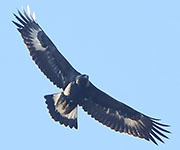 11/8 – Pine Plains, HRM 98: I went on a short walk in the fields north of Pine Plains looking, with no success, for common redpolls. Consolation prize: High in the sky an immature golden eagle working the fields. I noted the white base of its tail and white wing patches. Looking closely, I could see that the head and bill were much smaller, tidier than a bald eagle. (Photo of golden eagle courtesy of Deborah Tracy Kral) 11/8 – Pine Plains, HRM 98: I went on a short walk in the fields north of Pine Plains looking, with no success, for common redpolls. Consolation prize: High in the sky an immature golden eagle working the fields. I noted the white base of its tail and white wing patches. Looking closely, I could see that the head and bill were much smaller, tidier than a bald eagle. (Photo of golden eagle courtesy of Deborah Tracy Kral)
- Deborah Tracy Kral
11/8 – Town of Esopus, HRM 88: Today’s unseasonably warm weather allowed for another kayak adventure on the Hudson River. We put in at the fishing wall just north of Lighthouse Park and paddled south a few miles to find the tide changing on the west side of “the river that flows both ways.” We power-paddled back to the landing and the burst of energy provided warmth. However, we missed the best picture of the day: three mute swans in formation flying down the middle of the river—beautiful birds in the late afternoon sun. While loading up our kayaks, we met three adults catching white perch, yellow perch and brown bullheads. We wondered if they knew of the advisories on consuming certain Hudson River fishes.
- Betty Boomer
11/8 – Little Stony Point, HRM 55: The sun had not yet climbed over Mount Taurus, and the air was clear and crisp. The only blemish in the cerulean-blue sky was the 3rd quarter moon. Our morning seining was a good example of one of the vagaries of tidewater: Our first haul along the beach came up completely empty; on the second, the seine filled with young-of-year striped bass (65-75 millimeters (mm)); in the third of three, the net bulged with only banded killifish (48-110 mm), males with their lavender bands, females in subdued colors. Each haul created a temporary vacuum, the mechanics of which drew in fish from the surroundings. In our case, it brought new and even unrelated fish. The river was 58 degrees F, and the salinity was 2.0 parts-per-thousand (ppt).
- Tom Lake, Phyllis Lake
(One inch = 25.4 millimeters(mm))
11/8 – Bedford, HRM 35: We spotted 50 migrating raptors at the Bedford Audubon Chestnut Ridge Hawkwatch today; red-shouldered hawk was high count with 25. Turkey vulture (49) led among non-raptor migrants that also included cedar waxwing (126), pine siskin (45), American goldfinch (23), and American pipit (5).
- Richard Aracil, Karen Troche, Pedro Troche
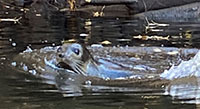 11/9 – Saugerties, HRM 102: I watched as the now “local”' harbor seal followed a kayaker. He almost appeared playful. The kayaker knew not to try and feed him, but others were reportedly trying. I successfully resisted tossing him the shrimp I had in my bag. (Photo of harbor seal courtesy of Erica Lovrin) 11/9 – Saugerties, HRM 102: I watched as the now “local”' harbor seal followed a kayaker. He almost appeared playful. The kayaker knew not to try and feed him, but others were reportedly trying. I successfully resisted tossing him the shrimp I had in my bag. (Photo of harbor seal courtesy of Erica Lovrin)
- Jeff Morton
11/9 – Saugerties, HRM 102: We selected a glorious warm and calm fall day to paddle at Saugerties in hopes of capturing a glimpse of the Hudson River harbor seal. We were paddling side-by-side, chatting as we went upstream on Esopus Creek. We spotted the seal when he surfaced between us at our sterns and then he dove under the water surfacing occasionally with some tail splashing. We were elated at this sighting and a wonderful wildlife encounter to end our paddle season. This was Day 461 for the harbor seal at Saugerties.
- Erica Lovrin, Ellen Luchsinger
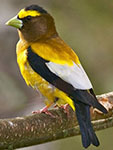 11/9 – Bedford, HRM 35: We spotted 69 migrating raptors at the Bedford Audubon Chestnut Ridge Hawkwatch today; red-shouldered hawk was high count with 47. Our highlight of the day was two golden eagles. The first bird was flying low while the second was quite high being mobbed by a raven. 11/9 – Bedford, HRM 35: We spotted 69 migrating raptors at the Bedford Audubon Chestnut Ridge Hawkwatch today; red-shouldered hawk was high count with 47. Our highlight of the day was two golden eagles. The first bird was flying low while the second was quite high being mobbed by a raven.
Just after arriving at the platform, we heard the flight calls of an evening grosbeak as it flew over headed west. We managed to get a momentary glimpse before it disappeared over the trees. Later, we heard another evening grosbeak but could not get visuals. (Photo of evening grosbeak courtesy of EJ Peiker)
- Richard Aracil, Pedro Troche
[Starting in the 1960s and continuing for some 25 years, flocks of evening grosbeaks began arriving in the lower Hudson River Valley area (especially Long Island) in mid-October. Prior to this, evening grosbeaks were occasional visitors from late December through early March. The high count for Central Park was 38 on 15 October 1961; and one evening grosbeak spent 10+ days in lower Manhattan in July 1975.
This week’s Banner Photo of an evening grosbeak is by Deborah Allen. Please join us on our Central Park Manhattan Bird Walks; the schedule can be found at www.BirdingBob.com. Robert DeCandido]
11/10 – Newcomb, HRM 302: For the second day in a row, air temperatures tied the record high for the date at 70 degrees F.
- National Weather Service
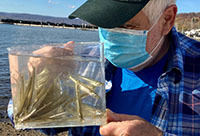 11/10 – Senasqua, HRM 36: The river was ebbing, but a strong south wind was blunting the tide. Every rock exposed by the tide was barnacle-covered. Although the salinity was just 6.0 ppt, we could still smell the salt in the air. The shallows had warmed to 62 degrees F, and our wading, as we hauled our net, was very comfortable. Not surprisingly, given the catches recorded during the recent Day-in-the-Life of the River and Harbor event, our seine repeatedly filled with Atlantic silverside (70-115 mm). In the bright afternoon sun, the net looked like a bag of silver. Mixed in were Atlantic menhaden and mummichogs (63-70 mm). (Photo of Atlantic silverside courtesy of Phyllis Lake) 11/10 – Senasqua, HRM 36: The river was ebbing, but a strong south wind was blunting the tide. Every rock exposed by the tide was barnacle-covered. Although the salinity was just 6.0 ppt, we could still smell the salt in the air. The shallows had warmed to 62 degrees F, and our wading, as we hauled our net, was very comfortable. Not surprisingly, given the catches recorded during the recent Day-in-the-Life of the River and Harbor event, our seine repeatedly filled with Atlantic silverside (70-115 mm). In the bright afternoon sun, the net looked like a bag of silver. Mixed in were Atlantic menhaden and mummichogs (63-70 mm). (Photo of Atlantic silverside courtesy of Phyllis Lake)
- Tom Lake, Phyllis Lake
[Senasqua translates from an Algonquian dialect (probably Lenape) as “place of the grass.” The grass was wild celery (Vallisneria americana), a native aquatic plant that favors the river’s tidal shallows. The dynamic ecology of Haverstraw Bay has changed much in historic times and, while wild celery is still present, the beds no longer appear like vast fields of grass. Tom Lake]
11/10 – Bedford, HRM 35: We spotted 14 migrating raptors at the Bedford Audubon Chestnut Ridge Hawkwatch today; red-tailed and sharp-shinned hawks shared high count with four each. We did see two adult bald eagles momentarily lock talons. Turkey vulture (18) led among non-raptor migrants.
- Richard Aracil, Pedro Troche, Karen Troche
11/10 – Hook Mountain, HRM 31: We spotted 30 migrating raptors, including four merlins and a golden eagle, at the Hook Mountain Hawkwatch today; turkey vulture (9) and black vulture (8) led among non-raptor migrants. In mid-afternoon, a lovely, fresh common buckeye butterfly prettied up the summit.
- John Phillips, Vince Plogar
11/10 – Manhattan, New York City: For the second day in a row, air temperatures—75 and 74 degrees F—tied the record high for the date.
- National Weather Service
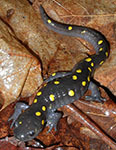 11/11 – Ulster County, HRM 90: The early bird got more than the worm this morning. Last night’s warm rain left a smorgasbord of amphibian delicacies on the road, for example eye of newt, muscled leg of frog, flattened toad, and the messy white “smoosh” of spotted salamander. However, the avian clean-up crews had gobbled up the protein treats and cleared the carnage before most of us began a new day. 11/11 – Ulster County, HRM 90: The early bird got more than the worm this morning. Last night’s warm rain left a smorgasbord of amphibian delicacies on the road, for example eye of newt, muscled leg of frog, flattened toad, and the messy white “smoosh” of spotted salamander. However, the avian clean-up crews had gobbled up the protein treats and cleared the carnage before most of us began a new day.
An up-turned petiole of a wet oak leaf on the dark wet pavement often suggests the shape I was seeking, but then I saw the unmistakable glint of a salamander sliding over the pavement. At dawn, I pulled off to help a seven-inch spotted salamander across the road, the first of many stops on this morning. I wondered if this was a new November record for salamander crossings. (Photo of spotted salamander courtesy of Bryan Pfeiffer)
- Lorna Tychostup, Betty Boomer
 11/12 – Kingston, HRM 92: Tonight’s sunset was just spectacular. Words were hardly necessary to describe its brilliance. The show provided us with a much welcome moment of pure awe. (Photo of sunset courtesy of Nancy Beard) 11/12 – Kingston, HRM 92: Tonight’s sunset was just spectacular. Words were hardly necessary to describe its brilliance. The show provided us with a much welcome moment of pure awe. (Photo of sunset courtesy of Nancy Beard)
- Nancy Beard
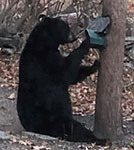 11/12 – East Fishkill, HRM 66: We take our bird feeders in every night. We learned our lesson after replacing too many broken bird feeders. But today we fell prey to a sneaky black bear. He arrived in daylight, found our new squirrel feeder, and had a feast. (Photo of black bear courtesy of Diane Anderson) 11/12 – East Fishkill, HRM 66: We take our bird feeders in every night. We learned our lesson after replacing too many broken bird feeders. But today we fell prey to a sneaky black bear. He arrived in daylight, found our new squirrel feeder, and had a feast. (Photo of black bear courtesy of Diane Anderson)
- Diane Anderson
[The DEC released a Guidance to Homeowners on how to avoid problems with black bears.
http://www.dec.ny.gov/press/113258.html]
11/12 – Bedford, HRM 35: We spotted just a single migrating raptor at the Bedford Audubon Chestnut Ridge Hawkwatch today, a bald eagle. Turkey vulture (40) led among non-raptor migrants.
- Richard Aracil
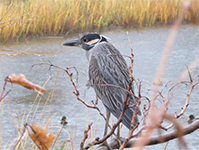 11/12 – Manhattan, New York City: The tide was high in mid-morning at Little Hell Gate Salt Marsh on the East River. A great egret was wading around in the salt marsh successfully catching what I believe were mummichogs. The prize, however, was an adult yellow-crowned night heron perched in a tree-of-heaven (Ailanthus altissima), looking drenched as the sky continued to drizzle. (Photo of yellow-crowned night heron courtesy of Jackie Wu) 11/12 – Manhattan, New York City: The tide was high in mid-morning at Little Hell Gate Salt Marsh on the East River. A great egret was wading around in the salt marsh successfully catching what I believe were mummichogs. The prize, however, was an adult yellow-crowned night heron perched in a tree-of-heaven (Ailanthus altissima), looking drenched as the sky continued to drizzle. (Photo of yellow-crowned night heron courtesy of Jackie Wu)
- Jackie Wu
*** Fish of the Week ***
 11/13 – Hudson River Watershed: Fish-of-the-Week for Week 96 is the inland silverside, Menidia beryllina, number 125 (of 234), on our Hudson River Watershed List of Fishes. If you would like a copy of our list, e-mail: trlake7@aol.com 11/13 – Hudson River Watershed: Fish-of-the-Week for Week 96 is the inland silverside, Menidia beryllina, number 125 (of 234), on our Hudson River Watershed List of Fishes. If you would like a copy of our list, e-mail: trlake7@aol.com
The inland silverside is one of four silverside (Atherinidae), a mix of both freshwater and saltwater species, in our watershed. They are on occasion, especially in older literature, called tidewater silverside. Inland silverside is found in coastal waters from Massachusetts to the Gulf of Mexico, as well as the Mississippi and Rio Grande rivers. They favor sand and gravel substrate where they feed primarily on crustaceans and grow to a maximum size of 105 millimeters. They have also been widely introduced in freshwater impoundments in the South.
The general consensus is that the inland silverside is uncommon in the estuary. In his Biological Survey of the Lower Hudson Watershed (1937), J.R. Greeley refers to inland silverside as “rare, much scarcer than Atlantic silverside.” However, they are around; it simply takes sharp eyes and extraordinary patience to find one.
Since their comfort zones overlap at times, inland silverside often mixes with large schools of Atlantic silverside. Noting their presence can be very tricky. Working through a net filed with hundreds of look-alike silverside, having a goal of limiting mortality, and trying to find the one needle-in-the-haystack based on a couple of very subtle morphological traits, is a challenge—they can easily be overlooked. Inland silverside has a broad comfort range of salinity (0-26 ppt), preferring lower salinity, and are more commonly found in brackish rather than saltwater.
Our most recent record occurred on December 9, 2017, at Kowawese (river mile 59). It was a very late date to expect finding silverside. B.J. Jackson, a member of our seining crew, somehow noticed that one of the fish in the seine looked just a bit different. It was an inland silverside (68 mm), caught on our last haul of the day, during our last sampling day of the season. The water temperature was 41 degrees F, and the salinity was 2.0 ppt. (Photo of inland silverside courtesy of Tom Lake)
- Tom Lake
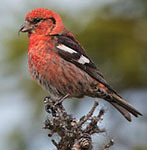 11/13 – Saratoga County, HRM 200: We did our bimonthly Galway, Edinburg, Providence and Lake Desolation State Forest tour looking for interesting waterfowl and the presence of winter finches. 11/13 – Saratoga County, HRM 200: We did our bimonthly Galway, Edinburg, Providence and Lake Desolation State Forest tour looking for interesting waterfowl and the presence of winter finches.
Galway Lake is in the process of being drained and, as a result, waterfowl were concentrated in the middle. We counted six long-tailed ducks there a couple of weeks ago. Today’s count included ruddy ducks (35), ring-necked ducks (55), gadwall (four), hooded mergansers (75), bufflehead (17), a pied-billed grebe, and many Canada geese.
The highlight of our sojourn was at Archer Vly, a DEC campsite and lake, with many trails. A flock of 35 “winter finch-sounding” birds flew over the lake and into the woods. We found a trail in pursuit and eventually came upon a flock of common redpolls feeding on yellow birch cones. On our return to the lake, another smaller flock of winter finch landed behind us. Even in dreary light, it didn’t take long to identify them as white-winged crossbills, fourteen in all. I had not seen them in more than ten years. (Photo of white-winged crossbill courtesy of Jacob Spendelow)
- Ron Harrower, John Hershey (Hudson-Mohawk Bird Club)
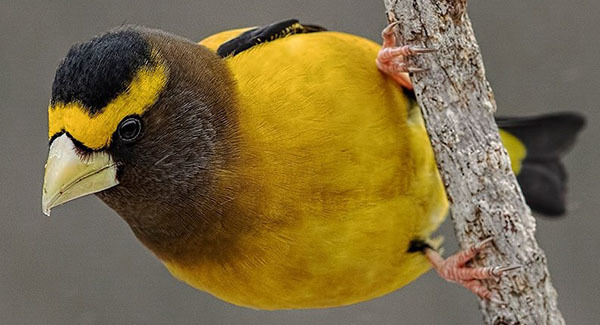
Fall 2020 Natural History Programs
Natural History Programs sponsored by the Livingston Free Library: Join us for thirty-minute presentations on Turtles, Climate Change, Invasive Species, and more followed by Q&A, presented by Naturalist Chelsea Moore of the NYSDEC Hudson River Estuary Program, offered every other Wednesday to the Livingston Library at 11:00 AM and to the Starr Library at 4:00 PM.
Snow and Ice (water chemistry and animal tracking)
Wednesday, December 4, 2020 11:00 AM and 4:00 PM
Winter trees (photosynthesis)
Wednesday, December 16, 2020 11:00 AM and 4:00 PM
Registration for Starr, e-mail: Daniel@starrlibrary.org
Registration for http://livingston.lib.ny.us/ or Livingstonlibrary105@gmail.com
The Estuary Live! (Hudson River Estuary Program)
Our environmental education programs are broad, varied, flexible, and dependent on the needs and interests of your students. These distance-learning programs can last anywhere from 30 minutes to an hour and are available on ZOOM, Google classrooms, or Webex platforms. Pre-program materials from our Virtual River content include videos and lesson plans for students to explore before their Estuary Live! program. Students are encouraged to ask questions which creates an interactive learning environment, rather than a lecture. Estuary Live! is often hosted from an outdoor location but is dependent on the weather and cell service. The Norrie Point Environmental Center has three indoor sets (The Library, The Lab, and The Classroom) that allow us to stay connected during lessons and give students a feeling of being here with us.
Program types and a brief description of the topics:
Wildlife (e.g., amphibians, turtles, and fish)
Hudson River basics, e.g. geography, tides, salinity, turbidity, temperature, basic ecology.
Climate change
American Eels
Stream Study: macroinvertebrates, e.g., adaptations, habitat, and human impact.
Educators can schedule a program for their students:
https://docs.google.com/forms/d/e/1FAIpQLScr6Sidcq70JL3xLvubH1J-WfAkRMsR6AWvUtHsdcOiUvXrcw/viewform
Contact Maija Lisa Niemistö email:maija.niemisto@dec.ny.gov
Follow Us On-Line:
Check out our wonderful Tide Finder video (3 minutes) with Chris Bowser marking the extreme highs and lows of a full moon tidal cycle: Tide Finder video
Virtual River website: Virtual River Website
Hudson River Miles
The Hudson is measured north from Hudson River Mile 0 at the Battery at the southern tip of Manhattan. The George Washington Bridge is at HRM 12, the Tappan Zee 28, Bear Mountain 47, Beacon-Newburgh 62, Mid-Hudson 75, Kingston-Rhinecliff 95, Rip Van Winkle 114, and the Federal Dam at Troy, the head of tidewater, at 153. The tidal section of the Hudson constitutes a bit less than half the total distance – 315 miles – from Lake Tear of the Clouds to the Battery. Entries from points east and west in the watershed reference the corresponding river mile on the mainstem.
To Contribute Your Observations or to Subscribe
The Hudson River Almanac is compiled and edited by Tom Lake and emailed weekly by DEC's Hudson River Estuary Program. Share your observations by e-mailing them to trlake7@aol.com. To subscribe to the Almanac (or to unsubscribe), use the links on DEC's Hudson River Almanac or DEC Delivers web pages.
Discover New York State
The Conservationist, the award-winning, advertisement-free magazine focusing on New York State's great outdoors and natural resources. The Conservationist features stunning photography, informative articles and around-the-state coverage. Visit The Conservationist webpage for more information.
Useful Links
National Oceanic and Atmospheric Administration online tide and tidal current predictions are invaluable when planning Hudson River field trips. For real-time information on Hudson River tides, weather and water conditions from sixteen monitoring stations, visit the Hudson River Environmental Conditions Observing System website.
DEC's Smartphone app for iPhone and Android is now available at: New York Fishing, Hunting & Wildlife App.
PLAY SMART * PLAY SAFE * PLAY LOCAL: Get Outside Safely, Responsibly, and Locally
New York State is encouraging residents to engage in responsible recreation during the ongoing COVID-19 public health crisis. NYSDEC and State Parks recommendations for getting outside safely incorporate guidance from the Centers for Disease Control and Prevention and the NYS Department of Health for reducing the spread of infectious diseases.
DEC and State Parks are encouraging visitors to New York's great outdoors to use the hashtags #PlaySmartPlaySafePlayLocal, #RecreateResponsibly, and #RecreateLocal on Facebook, Twitter, and Instagram to share their visit and encourage others to get outside safely, responsibly, and locally, too. Use the DECinfo Locator to find a DEC-managed resource near you and visit the State Parks website for information about parks and park closures.
Take the Pledge to PLAY SMART * PLAY SAFE * PLAY LOCAL: Enjoy the Outdoors Safely and Responsibly
1. I pledge to respect the rules and do my part to keep parks, beaches, trails, boat launches, and other public spaces safe for everyone.
2. I will stay local and close to home.
3. I will maintain a safe distance from others outside of my household.
4. I will wear a mask when I cannot maintain social distancing.
5. I accept that this summer, I may have to adjust how I enjoy the outdoors to help keep myself and others healthy and safe, even if it means changing my plans to visit a public space.
6. I will be respectful of others by letting them pass by me if needed on a trail and keeping my blanket ten feet apart from others on the beach.
7. I will move quickly through shared areas like parking lots, trailheads, and scenic areas to avoid crowding.
8. If I'm not feeling well, I will stay home.
Information about the Hudson River Estuary Program is available on DEC's website at http://www.dec.ny.gov/lands/4920.html.
|


 11/7 – Kingston, HRM 92: While walking in my neighborhood today, I found some milkweed (Asclepias syriaca), many of whose pods were ready to release their seeds to the next gust of wind. Other pods were still waiting with their seeds so perfectly packaged. (Photo of milkweed courtesy of Nancy Beard)
11/7 – Kingston, HRM 92: While walking in my neighborhood today, I found some milkweed (Asclepias syriaca), many of whose pods were ready to release their seeds to the next gust of wind. Other pods were still waiting with their seeds so perfectly packaged. (Photo of milkweed courtesy of Nancy Beard) 11/7 – Dutchess County, HRM 100: I was hiking the Quarry Hill Trail (1,600-foot elevation), an access trail that leads from the western side of the Taconic range up to the South Taconic Trail just south of Brace Mountain. It was on the trail where I stumbled upon a small northern red-bellied snake (Storeria occipitomaculata) on a west-facing, sun-warmed rock. It was very small, maybe six-inches-long, and slender as a chopstick. I watched it register my presence and struggle to scale a steep rock face. The snake succeeded in getting up by moving to an adjacent moss-covered rock a few inches away and then made its way through the greenery and into the leaf litter off the trail. (Photo of northern red-bellied snake courtesy of Moira Stone)
11/7 – Dutchess County, HRM 100: I was hiking the Quarry Hill Trail (1,600-foot elevation), an access trail that leads from the western side of the Taconic range up to the South Taconic Trail just south of Brace Mountain. It was on the trail where I stumbled upon a small northern red-bellied snake (Storeria occipitomaculata) on a west-facing, sun-warmed rock. It was very small, maybe six-inches-long, and slender as a chopstick. I watched it register my presence and struggle to scale a steep rock face. The snake succeeded in getting up by moving to an adjacent moss-covered rock a few inches away and then made its way through the greenery and into the leaf litter off the trail. (Photo of northern red-bellied snake courtesy of Moira Stone) 11/8 – Pine Plains, HRM 98: I went on a short walk in the fields north of Pine Plains looking, with no success, for common redpolls. Consolation prize: High in the sky an immature golden eagle working the fields. I noted the white base of its tail and white wing patches. Looking closely, I could see that the head and bill were much smaller, tidier than a bald eagle. (Photo of golden eagle courtesy of Deborah Tracy Kral)
11/8 – Pine Plains, HRM 98: I went on a short walk in the fields north of Pine Plains looking, with no success, for common redpolls. Consolation prize: High in the sky an immature golden eagle working the fields. I noted the white base of its tail and white wing patches. Looking closely, I could see that the head and bill were much smaller, tidier than a bald eagle. (Photo of golden eagle courtesy of Deborah Tracy Kral) 11/9 – Saugerties, HRM 102: I watched as the now “local”' harbor seal followed a kayaker. He almost appeared playful. The kayaker knew not to try and feed him, but others were reportedly trying. I successfully resisted tossing him the shrimp I had in my bag. (Photo of harbor seal courtesy of Erica Lovrin)
11/9 – Saugerties, HRM 102: I watched as the now “local”' harbor seal followed a kayaker. He almost appeared playful. The kayaker knew not to try and feed him, but others were reportedly trying. I successfully resisted tossing him the shrimp I had in my bag. (Photo of harbor seal courtesy of Erica Lovrin) 11/9 – Bedford, HRM 35: We spotted 69 migrating raptors at the Bedford Audubon Chestnut Ridge Hawkwatch today; red-shouldered hawk was high count with 47. Our highlight of the day was two golden eagles. The first bird was flying low while the second was quite high being mobbed by a raven.
11/9 – Bedford, HRM 35: We spotted 69 migrating raptors at the Bedford Audubon Chestnut Ridge Hawkwatch today; red-shouldered hawk was high count with 47. Our highlight of the day was two golden eagles. The first bird was flying low while the second was quite high being mobbed by a raven.  11/10 – Senasqua, HRM 36: The river was ebbing, but a strong south wind was blunting the tide. Every rock exposed by the tide was barnacle-covered. Although the salinity was just 6.0 ppt, we could still smell the salt in the air. The shallows had warmed to 62 degrees F, and our wading, as we hauled our net, was very comfortable. Not surprisingly, given the catches recorded during the recent Day-in-the-Life of the River and Harbor event, our seine repeatedly filled with Atlantic silverside (70-115 mm). In the bright afternoon sun, the net looked like a bag of silver. Mixed in were Atlantic menhaden and mummichogs (63-70 mm). (Photo of Atlantic silverside courtesy of Phyllis Lake)
11/10 – Senasqua, HRM 36: The river was ebbing, but a strong south wind was blunting the tide. Every rock exposed by the tide was barnacle-covered. Although the salinity was just 6.0 ppt, we could still smell the salt in the air. The shallows had warmed to 62 degrees F, and our wading, as we hauled our net, was very comfortable. Not surprisingly, given the catches recorded during the recent Day-in-the-Life of the River and Harbor event, our seine repeatedly filled with Atlantic silverside (70-115 mm). In the bright afternoon sun, the net looked like a bag of silver. Mixed in were Atlantic menhaden and mummichogs (63-70 mm). (Photo of Atlantic silverside courtesy of Phyllis Lake) 11/11 – Ulster County, HRM 90: The early bird got more than the worm this morning. Last night’s warm rain left a smorgasbord of amphibian delicacies on the road, for example eye of newt, muscled leg of frog, flattened toad, and the messy white “smoosh” of spotted salamander. However, the avian clean-up crews had gobbled up the protein treats and cleared the carnage before most of us began a new day.
11/11 – Ulster County, HRM 90: The early bird got more than the worm this morning. Last night’s warm rain left a smorgasbord of amphibian delicacies on the road, for example eye of newt, muscled leg of frog, flattened toad, and the messy white “smoosh” of spotted salamander. However, the avian clean-up crews had gobbled up the protein treats and cleared the carnage before most of us began a new day.  11/12 – Kingston, HRM 92: Tonight’s sunset was just spectacular. Words were hardly necessary to describe its brilliance. The show provided us with a much welcome moment of pure awe. (Photo of sunset courtesy of Nancy Beard)
11/12 – Kingston, HRM 92: Tonight’s sunset was just spectacular. Words were hardly necessary to describe its brilliance. The show provided us with a much welcome moment of pure awe. (Photo of sunset courtesy of Nancy Beard) 11/12 – East Fishkill, HRM 66: We take our bird feeders in every night. We learned our lesson after replacing too many broken bird feeders. But today we fell prey to a sneaky black bear. He arrived in daylight, found our new squirrel feeder, and had a feast. (Photo of black bear courtesy of Diane Anderson)
11/12 – East Fishkill, HRM 66: We take our bird feeders in every night. We learned our lesson after replacing too many broken bird feeders. But today we fell prey to a sneaky black bear. He arrived in daylight, found our new squirrel feeder, and had a feast. (Photo of black bear courtesy of Diane Anderson)  11/12 – Manhattan, New York City: The tide was high in mid-morning at Little Hell Gate Salt Marsh on the East River. A great egret was wading around in the salt marsh successfully catching what I believe were mummichogs. The prize, however, was an adult yellow-crowned night heron perched in a tree-of-heaven (Ailanthus altissima), looking drenched as the sky continued to drizzle. (Photo of yellow-crowned night heron courtesy of Jackie Wu)
11/12 – Manhattan, New York City: The tide was high in mid-morning at Little Hell Gate Salt Marsh on the East River. A great egret was wading around in the salt marsh successfully catching what I believe were mummichogs. The prize, however, was an adult yellow-crowned night heron perched in a tree-of-heaven (Ailanthus altissima), looking drenched as the sky continued to drizzle. (Photo of yellow-crowned night heron courtesy of Jackie Wu) 11/13 – Hudson River Watershed: Fish-of-the-Week for Week 96 is the inland silverside, Menidia beryllina, number 125 (of 234), on our Hudson River Watershed List of Fishes. If you would like a copy of our list, e-mail:
11/13 – Hudson River Watershed: Fish-of-the-Week for Week 96 is the inland silverside, Menidia beryllina, number 125 (of 234), on our Hudson River Watershed List of Fishes. If you would like a copy of our list, e-mail:  11/13 – Saratoga County, HRM 200: We did our bimonthly Galway, Edinburg, Providence and Lake Desolation State Forest tour looking for interesting waterfowl and the presence of winter finches.
11/13 – Saratoga County, HRM 200: We did our bimonthly Galway, Edinburg, Providence and Lake Desolation State Forest tour looking for interesting waterfowl and the presence of winter finches. 